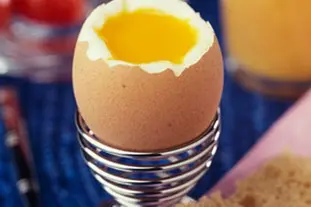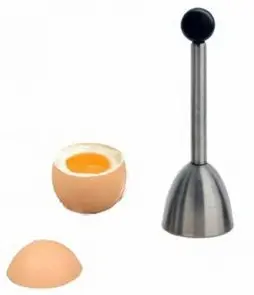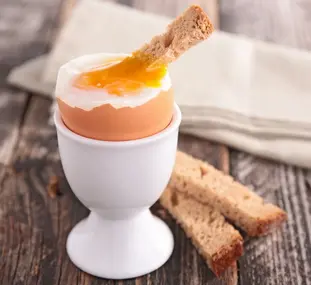The perfect boiled egg

Making boiled eggs is always a delight and it pleases the young and old alike. This little transgenerational side puts them on the list of "things to do on Sunday evening when you don't know what to do" in many families (including mine)...
That said, it's not that simple, you have to pay attention to several details, which if not respected could (a little) spoil the moment.
That said, it's not that simple, you have to pay attention to several details, which if not respected could (a little) spoil the moment.
18 K 4.7/5 (28 reviews)
Keywords for this post:CookingEggTipLast modified on: January 30th 2021
The perfect boiled egg
What is a "perfect" boiled egg?
It's very subjective of course, but let's try to list what's important:- Its shell is whole, not cracked or split
- It is impeccably cooked: the white is set, completely, but not the yolk, which has remained liquid (otherwise it is a soft-boiled egg, or even hard-boiled)
- When you cut the cap (the top) you don't put small pieces of shell in the egg
- It is served with "mouillettes", an essential French concept, which deserves a real good bread
That's it, now let's see how to try to get as close as possible to this noble goal.
How to do it ?
A big effort on the cooking, you will have understood, and for that you must absolutely respect the basic rules of cooking eggs in water:1) If possible, use fresh, quality eggs, and take them out of the fridge, if they are there (which is not necessary), at least 1 hour beforehand, so that they come back to room temperature, otherwise the cooking time becomes random
2) Everyone goes to the table at the beginning of the cooking, boiled eggs don't wait
3) We pierce the base of the egg shell with a needle or a nail, to burst the air pocket that is there, so the shell does not crack during cooking

4) Do not salt or vinegar the cooking water, it is useless
5) Put the eggs gently into the boiling water with a soup spoon
6) Cook for exactly 3 minutes, not less, and from the moment the water comes back to the boil, which means you don't have to worry about the number of eggs in the pan
That's it, most of the work is done. You put your eggs in egg cups and then directly to the table.
The tasting
Cutting
Classically, we cut the top of the egg with a knife by tapping and turning all around, gesture not very practical. If your family is a "big" consumer of boiled eggs, you can consider buying a "toc-oeuf" or "toqueur", it is a small, simple and not very expensive utensil, with a small spring and a weight that makes in 1 second an almost perfect cut of an egg cap, it is what all restaurants use.If you have young children, or grandchildren, you will surely look like a magician to them, when they first use this tool.

The "mouillettes"
There is no boiled egg worthy of the name without "mouillettes", i.e. small sticks of bread that you dip in the yolk to taste it, it is all the delight of boiled eggs.The mouillettes deserve a special treatment, it would be a shame to just take a slice of bread cut into sticks (although... in case of a big laziness).

1) Cut a piece of baguette 7 or 8 cm long, depending on the age of your guests
2) Cut this piece in 2 in the height and put them in the toaster
3) Cut each piece into sticks and spread with a little butter
4) Taste...
You can also decorate the mouillettes by putting on top, rather in thin slices, a little ham, salmon, cheese, etc. according to your taste.
Obviously, all this may seem a little complicated, a little long, but not so much, and you will see that in time, you will do it naturally without really making an effort.
In summary: Take particular care with the cooking, use a toc-egg if necessary, and make beautiful and good mussels.
Lasts posts
Butter vs. grease
We often read in a recipe where a pastry is put into a mould that, just before pouring, the mould should be buttered or greased. But what's the difference between these 2 terms?December 1st 20251,3585
Getting out of the fridge early
Very often when you're cooking, you need to take food or preparations out of the fridge, to use them in the recipe in progress. There's nothing tricky about this: you just take them out of the fridge and use them, usually immediately, in the recipe. But is this really a good method?November 24th 20251,2625
Who's making the croissants?
When you look at a bakery from the outside, you naturally think that in the bakery, the bakers make the bread, and in the laboratory, the pastry chefs make the cakes. It's very often like that, with each of these professions having quite different ways of working, but sometimes there's also one...November 23th 20251,146
Oven height
When we put a dish or cake in the oven, we naturally tend to put it on the middle shelf, and that's what we usually do. But in some cases, this position and height can be a little tricky, so let's find out why.October 8th 20253,1775
The importance of sieving
In recipes that use a fine powder (flour, powdered sugar, etc.), you'll often see the advice to sift before using it. To sift is to pass the powder in question through a sieve (a very fine strainer) before incorporating it into your recipe. It's often advice, but is it really useful?September 3rd 20257,8333
Other pages you may also like
The beautiful story of the croissants
As you may have already noticed, cooking, baking and pastry-making are full of stories or legends, usually very romantic, about this or that product or recipe. This is often the case for named recipes, for example tarte tatin, peach melba, paris-brest and many others, but it also applies to very...October 10th 201820 K5
Fruits which can ruin your jelly
There are many ways of making a fruit mousse, but one of the simplest is to prepare a fruit jelly (basically a fresh fruit coulis with gelatine) and then mix this jelly before it sets completely with whipped cream. The result is perfect for filling a charlotte, for example. But do beware;...March 6th 201379 K4.0
The window-pane test in bread-making
The home bread-makers often ask themselves “Have I kneaded my dough long enough?” . A good question, as dough that is insufficiently kneaded will not rise properly or will fall flat when the top is slashed, which is very frustrating. To know when the dough is ready, one can rely on the length...June 16th 202197 K 23.9
Making the most of seeds: Dry roasting
In cooking, and particularly in baking, there are a lot of seeds we can use, such as linseed, sesame, poppy, etc. Usually, recipes simply say to add them just as they are to the mixture or dough. To make a seeded loaf, for example, prepare a plain bread dough as usual, then, towards the end of...January 30th 201562 K4.0
When should I change my knife?
I already spoke to you in a previous post about knives, those without which nothing is possible (or almost) in the kitchen, so I'm going to come back to them a bit and try to answer the question "When should I change my knife?November 2nd 201715 K4.7
Post a comment or question
Follow this page
If you are interested in this page, you can "follow" it, by entering your email address here. You will then receive a notification immediately each time the page is modified or a new comment is added. Please note that you will need to confirm this following.
Note: We'll never share your e-mail address with anyone else.
Alternatively: you can subscribe to the mailing list of cooling-ez.com , you will receive a e-mail for each new recipe published on the site.









